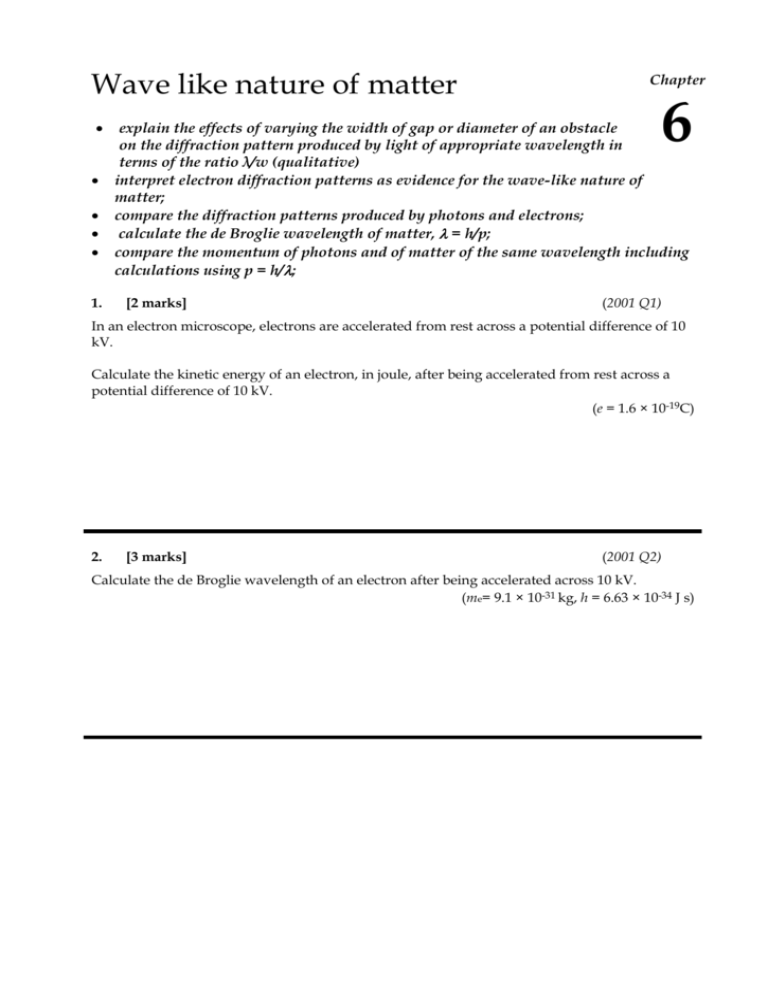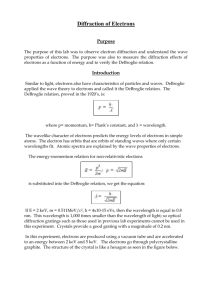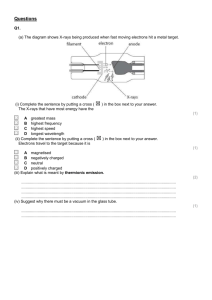Wave like nature of light
advertisement

Wave like nature of matter 1. Chapter 6 explain the effects of varying the width of gap or diameter of an obstacle on the diffraction pattern produced by light of appropriate wavelength in terms of the ratio λ/w (qualitative) interpret electron diffraction patterns as evidence for the wave-like nature of matter; compare the diffraction patterns produced by photons and electrons; calculate the de Broglie wavelength of matter, = h/p; compare the momentum of photons and of matter of the same wavelength including calculations using p = h/; [2 marks] (2001 Q1) In an electron microscope, electrons are accelerated from rest across a potential difference of 10 kV. Calculate the kinetic energy of an electron, in joule, after being accelerated from rest across a potential difference of 10 kV. (e = 1.6 × 10-19C) 2. [3 marks] (2001 Q2) Calculate the de Broglie wavelength of an electron after being accelerated across 10 kV. (me= 9.1 × 10-31 kg, h = 6.63 × 10-34 J s) 3. [3 marks] (2001 Q3) The two images below show a radiolarian, a unicellular organism, taken with an electron microscope and an optical microscope. The electron microscope gives a clearer image than the optical microscope. Explain why the electron microscope gives a clearer image than the optical microscope. 4. [2 marks] (2002 Q1) The figure above shows a picture of diffraction of X-rays and electrons through aluminium foil. The picture has been made by combining an X-ray diffraction pattern (on the right) with an electron diffraction pattern (on the left). The pictures are to the same scale and the X-rays have a photon energy of 70 keV. Calculate the wavelength of the 70 keV X-rays. (h = 4.14 × 10-15 eV s, c = 3.0 × 108 m s-1) 5. [2 marks] (2002 Q2) What is the de Broglie wavelength of the electrons? 6. [4 marks] (2002 Q3) Calculate the kinetic energy of the electrons in keV. (h = 6.6 × 10-34 J s, me = 9.1 × 10-31 kg, e = 1.6 × 10-19 C) 7. [2 marks] (2002 Q4) Which of the statements (A – D) best explains why it is possible to compare X-ray and electron diffraction patterns? A. X-rays can exhibit particle-like properties. B. Electrons can exhibit wave-like properties. C. Electrons are a form of high energy X-rays. D. Both electrons and X-rays ionise matter. 8. [4 marks] (2003 Q3) An electron gun accelerates electrons across a potential difference of 2500 V. The initial speed of the electrons can be considered to be almost zero. Show that the final speed of the electrons is approximately 10% of the speed of light. (me = 9.1 × 10-31 kg, c = 3.0 × 108 m s-1, e = 1.6 × 10-19 C) 9. [4 marks] (2004 Q5) An electron is accelerated from rest between two parallel charged plates in a vacuum with a potential difference of 100 V. Calculate the de Broglie wavelength of the electron just before it hits the positive plate. (e = 1.6 × 10-19 C, me = 9.1 × 10-31 kg, h = 6.63 × 10-34 J s) 10. [2 marks] (2004 Sample Q7) The figures below are two images that have been obtained by scattering electrons and x-rays off a collection of many small crystals with random orientations. The pictures are all to the same scale, and the x-rays have a wavelength of 35×10-12 m. Why do the patterns observed appear so similar? 11. [2 marks] (2004 Sample Q8) Calculate the energy of the x-rays in keV. 12. [2 marks] Provide an estimate for the de Broglie wavelength of the electrons. (2004 Sample Q9) 13. [2 marks] (2004 Pilot Q7) Figure a is the image obtained by scattering electrons off a collection of many small crystals with random orientation. Figure b, which is reproduced to the same scale, is the diffraction image obtained with the scattering of x-rays rather than electrons. The x-rays have a wavelength of 35 pm. Figure a Figure b The scattering of electrons and x-rays produces similar diffraction patterns. Which one of the following best explains why this occurs? A. they have the same wavelength B. they have the same frequency C. they have the same speed D. they have the same energy 14. [3 marks] (2004 Pilot Q8) Calculate the momentum of the electrons in Figure 6.4a. Make sure you include units in your answer. (me = 9.1 × 10-31 kg, h = 6.63 × 10-34 J s, c = 3.0 × 108 m s-1) 15. [3 marks] (2005 Q6) A sketch of a cathode ray tube (CRT) is shown below. In this device, electrons of mass 9.10 × 1031 kg are accelerated to a velocity of 2.0 × 107 m s-1. A fine wire mesh in which the gap between the wires is w = 0.50 mm has been placed in the path of the electrons, and the pattern produced is observed on the fluorescent screen. Planck’s constant: h = 6.63 × 1034 J s Calculate the de Broglie wavelength of the electrons. You must show your working. 16. [2 marks] (2005 Q7) Explain, with reasons, whether or not the students would observe an electron diffraction pattern on the fluorescent screen due to the presence of the mesh. 17. [2 marks] (2006 Q9) A beam of X-rays, wavelength λ = 250 pm (250 × 10-12 m), is directed onto a thin aluminium foil as shown below. The X-rays scatter from the foil onto the photographic film. Calculate the energy, in keV, of these X-rays. 18. [2 marks] (2006 Q10) After the X-rays pass through the foil, a diffraction pattern is formed as shown in Figure a. In a later experiment, the X-rays are replaced with a beam of energetic electrons. Again, a diffraction pattern is observed which is very similar to the X-ray diffraction pattern. This is shown in Figure b. Figure a Figure b Explain why the electrons produce a diffraction pattern similar to that of the X-rays. 19. [3 marks] (2006 Q11) Assuming the two diffraction patterns are identical, estimate the momentum of the electrons. Include the unit. 20. [3 marks] (2007 Q6) In an experiment, monochromatic laser light of wavelength 600 nm shines through a narrow slit, and the intensity of the transmitted light is recorded on the screen some distance away as shown below. The intensity pattern seen on the screen is also shown below. Which one of the intensity patterns (A - D) below best indicates the pattern that would be seen if a wider slit was used? 21. [2 marks] (VCE 2007 Q9) Electrons of mass 9.1 × 10-31 kg emerge from an electron gun with a speed of 2.0 × 107 ms-1. Question 9 What is the de Broglie wavelength of the electrons in nm? Show working.








